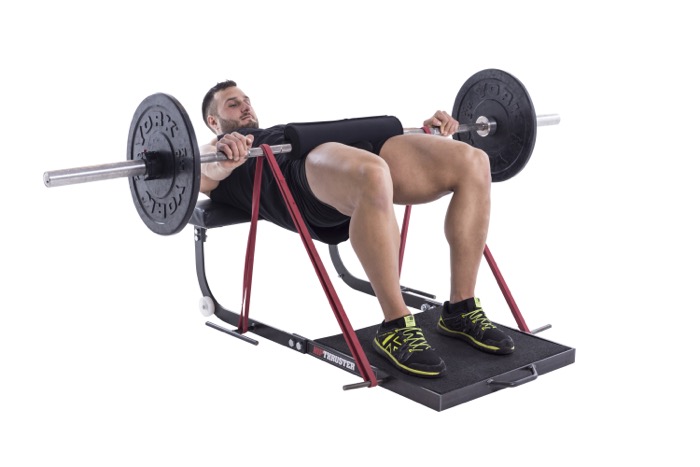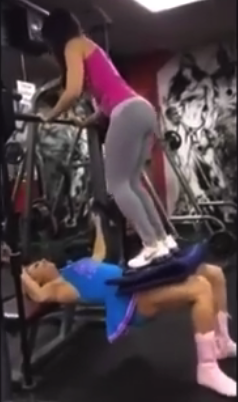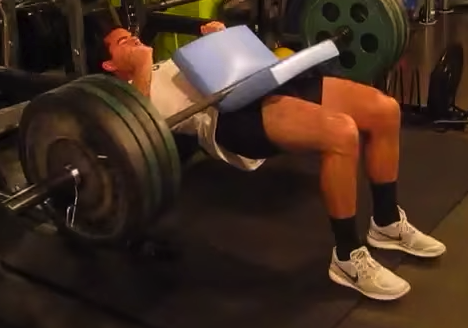The Hands-Free Hip Thrust: A Simple (Yet Very Effective) Hip Thrust Teaching Tool
By: Ben Bruno
I use hip thrusts extensively with virtually all of my clients.
The Hip Thruster is the best way to do the hip thrust – stable and versatile!
One of the things I like most about them is that they’re relatively easy to learn and there’s a fast learning curve so most clients can get the hang out if quickly.
Still, there are a few issues that I tend to see arise repeatedly.
- It takes people a little while to figure out the proper bar position on the hips, and until you find that sweet spot it can be awkward and uncomfortable.
- The name “hip thrust” could imply a fast explosive movement, but I actually prefer that they be done in a controlled fashion with a brief pause at the top of each rep. Sometimes stronger clients start to let their form slip as the weight on the bar increases and they start to try to thrust up violently, often failing to achieve full hip extension at the top. I tell my clients that if they can’t pause at the top, the weight is too heavy.
- I notice that a lot of clients tend to go into anterior pelvic tilt and overarch the lower back, especially as the weight gets heavier. This not only takes the stress off the glutes, but it’s also potentially injurious for the lower back. In all fairness, I must say I’ve never seen or heard of anyone getting hurt from hip thrusts (another reason I like them), but it’s still a concern. For both effectiveness and safety it’s important to keep a neutral spine, or if anything even a slight posterior pelvic tilt as you thrust up.
- Some clients tend to push harder through one foot than the other, which is easy to spot just by looking at the bar.
As a trainer, I can queue clients ad naueseum when I see form flaws, but whenever possible, I prefer to give drills or exercises that teach them to do the exercise correctly without me giving them too many things to think about.
Enter the hands-free hip thrust.
I’ve found that for clients who struggle with the aforementioned hip thrust issues, doing them hands-free can clear them all up very quickly.
Here’s a video of what it looks like in action.
When you don’t have your hands to hold the bar in place it forces you to find the right positioning on your hips. Just be sure to keep your hands close to the bar in case you need to grab it quickly for whatever reason.
Furthermore, if you thrust up too fast and don’t control the weight, or if you push more through one foot than the other, there’s no way you’ll be able to balance the bar on your hips. Likewise, if you overarch the lower back, the bar will slide down your hips, giving you immediate feedback. In order to keep the bar positioned correctly, it requires you to keep a neutral spine with a very slight posterior pelvic tilt at the top.
In this sense, the hands-free hip thrust is a lot like the hands-free front squat, which I also love and use as a teaching tool.
Form issues with front squats tend to be similar to those with hip thrusts; people struggle to support the bar, and they also tend to rush the reps and lose proper body positioning and fold forward. By going hands-free, it teaches you to support the bar on the shoulders instead of relying on the hands, and it allows forces you to stay upright and do the reps in a controlled fashion.
It’s the same idea for hands-free hip thrusts.
As a teaching tool, I recommend doing sets of 8-10 reps. I actually like doing something similar to what I do with front squats which is going hands-free for a few warm-up sets and then switching to regular hip thrusts as the weight gets heavier. Interestingly, I’ve noticed that my clients are often stronger with their normal hip thrusts after warming up with the hands-free version.
Now it’s important to note that while this may be a good teaching tool, it’s not a beginner exercise. I wouldn’t start off teaching hip thrusts hands-free. But for clients who have some experience with hip thrusts but either complain about feeling them in the lower back, or for clients who’ve gotten stronger but done so at the expense of good form, this method is a great way to take a step back and reset the form before continuing to add more weight.
For stronger lifters, hands-free hip thrusts can also function as a great standalone exercise that allows you to get an awesome training effect with lighter loads. In this case, I like doing 1-2 higher rep sets of 15-20 reps after you’ve done your heavier sets. You won’t be able to handle as much weight, but a 20-rep set of these with pauses at the top has my glutes begging for mercy more than almost any hip thrust variation I’ve ever tried.
If you’re the type who enjoys watching others suffer, here’s me doing a 20 rep finisher.
Give these a try and see if it doesn’t clean up the technique and allow you to feel the exercise even more in your glutes and less in the lower back.
About the Author:
Ben Bruno is a personal trainer in Los Angeles, California. He also  publishes a blog and free newsletter at www.benbruno.com. You can connect with him on social media at the following places:
publishes a blog and free newsletter at www.benbruno.com. You can connect with him on social media at the following places:
Instagram: https://instagram.com/benbrunotraining/
Twitter: https://twitter.com/benbruno1
Facebook: https://www.facebook.com/pages/Ben-Bruno/282118145176459
Youtube: https://www.youtube.com/bruno082985









Very well written article
Thanks!
Good stuff, Ben! I love the idea of finding exercise variations that allow the lifter to self-correct, instead of the trainer having to cue them.
Two questions, either for Bret or Ben:
1. Any ideas about how the hands-free version “potentiates” the hands-on one? Maybe by firing up the stabilizing muscles, enabling the glute max to work only at extending the hip?
2. For trainees who feel the hands-on version in their low back, does the hands-free version better target the glutes because of the necessity for the slight posterior pelvic tilt, or is there another explanation? Thanks!
Not Ben or Bret, but I’ll bite, Travis:
1. The potentiation centers on the transition from a more unstable variation to a more stable variation. First, you lock in the stabilization pattern using the hips and abs only, then when you grab the bar in the hands, the prime movers feel free to go nuts.
Guess you could compare it to doing ring dips, and then jumping on stable dip bars; you will likely be far more powerful, as your CNS quickly does the math, and figures out there is far less chance of injury if the prime movers fire more…robustly.
2. Hands free or not, the low back needs protection from the front. Fire the abs and do a plank, or in my case attempt an actual crunch. (It wont happen, but it locks in the pelvis for the glutes.) The glutes need the abs to go nuts. The body likes to protect the spine, and will shut down the muscles of the hip to do this if need be.
Also, here’s another dirty trick with this one: If you have access to a short bar, (Walmart sells a 5-ft OLY bar), the balance component is lessened as you have a shorter lever to balance on either side. A curl bar will work as well, but it’s a little off due to the zigzag.
P.S.>Excellent writeup, Ben. I immediately thought of zombie SQ, and how it cleans up form on FSQ, and the next paragraph, there it was. So true.
Sort of related: It occurs to me on point #1, that these protective mechanisms/co-contractions also may explain why some might learn to feel the glutes more with bands, esp. early on.
I find bands a great potentiator (is that a word?) as well; the body quickly discovers that the bands are going to provide growing antagonistic force to protect the joint/spine from traveling too far in an explosive fashion.
The CNS doesn’t want you to hurt yourself, and sometimes can be coaxed into giving more with “tricks”.
What if you did hands free, plus bands? Hmmm…I feel a personal experiment coming on..
Thanks Derrick! Travis, this response is way better than mine 🙂
Thanks, Derrick and Ben!
Thanks Travis!
1. Your idea makes sense and that’d be my guess as well, but to be honest I don’t really know why, I just know that it makes it easier. Any rationale I’d give would just be speculation.
2. I think part of it is as you said, and the other part is simply that going hands-free forces you to slow it down, pause at the top, and use more a controlled motion as opposed to a more explosive thrust.
This is awesome – I tried it yesterday and it really made a big difference to my form and making sure I really worked the mechanics properly. Thank you!
Awesome, glad it helped!
Ben, why do you opt to “irradiate” with clenched fists on the hands free HT, and yet not on the hands free FSQ/Zombie SQ?
Hey Derrick, I’m certainly not an expert in the concept of irradiation, but I actually think I did “irradiate” in the front squat video. If you look at the video, my arms are very straight and I’m focusing on keeping them straight and creating as much tension as possible. I prefer straight hands to fists for front squats because it helps with envision that I’m reaching, which helps keeps the arms straight and in turn keep tension in the arms. On most exercises I like to use fists (hip thrusts, the off hand on single leg RDLs, the off hand on landmine presses, etc.) but on front squats keeping the hands perfectly straight helps me best.
Awesome, Ben, great feedback, and thanks for taking the time to reply! I greatly value your perspective.
I ask b/c I have found irradiation concepts, like most cueing schemas, to be a mixed bag. Sometimes useful, sometimes distracting, highly unique to the individual.
In my own case, I tend to overdo the stabilization, and find myself in some weird, self-imposed catatonia, locked up and unable to move, ha hal! I irradiate too much!
The closest Irradiation type technique that I’ve found useful is to “become the bar”, or “join the bar”, on pulls, rows, which is a “set it and forget it cue”, THEN focus on pulling through the elbow. Plus I find that grip=rotator cuff. The two seem inseparable to me. And hard grip on the pinkie side heel of the hand=improved infraspinatus and lat activation, analogous to force through lateral heel=glute max/glute med.
But I run into trouble when I start consciously and intentionally irradiating back and forth across the lower body to the upper body (fists and hips, etc..). My brain can only focus on so much, I guess. Again, these are just my idiosyncrasies.
Many times, I find one small inner cue/concept, usually external, ties a lift together, ala, “hamstring curl the floor” on the way down on SQ’s, (amazing), or “bring the navel to the ribs” on HT, (locks the spine, effects a nice, tight PPT), etc.
And thus concludes another episode of “Derrick Rambles Uncontrollably about Minutiae!” 🙂
Thank you so much for this post, it’s never occurred to me to try hands free hip thrust or front squat to self-correct any imbalances/mistakes in these movements. I’m contemplating trying this for for split squats & lunges also. I foresee some hands-free work in my very near future…Thanks again.
Great glad it helped!
Excelent it is!
Thanks!
As I have been hip thrusting and strengthened my glutes, I noticed a significant difference in size of the right vs left glutes. To work the weaker left glute, I started doing only single legged glute exercises, such as single leg hip thrust with two 25lb plates on stomach and 5-lb ankle weights, weighted Bulgarian split squats, weighted donkey kicks on butt-blaster machines, etc. There has not been much progress, which is very difficult to accept. Recently I started using a heavier load on the weaker side and a lighter load on the ‘bigger’ side. What else and what different should I do ?